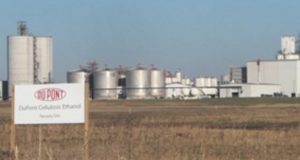 The DuPont cellulosic ethanol plant that opened in Nevada, Iowa, on October 30, will be the largest cellulosic ethanol plant in the world. The facility is expected to produce about 30 million gallons of cellulosic ethanol per year from corncobs, husks and stalks that are harvested within a 30-mile radius of the site. Most of this fuel will be shipped to California.
The DuPont cellulosic ethanol plant that opened in Nevada, Iowa, on October 30, will be the largest cellulosic ethanol plant in the world. The facility is expected to produce about 30 million gallons of cellulosic ethanol per year from corncobs, husks and stalks that are harvested within a 30-mile radius of the site. Most of this fuel will be shipped to California.
Iowa Gov. Terry Branstad; Sen. Chuck Grassley, R-Iowa; Rep. Steve King, R-Iowa, U.S. Department of Energy (DOE) Bioenergy Technologies Office Director Jonathan Male, senior government officials, DuPont leaders and staff, and local farmers, attended the event. Political leaders paid tribute to DuPont’s efforts to develop the next-generation low-carbon renewable fuel and criticized the U.S. Environmental Protection Agency’s proposal to reduce the amount of ethanol that will be blended in the nation’s transportation fuel supply. (Along with transportation fuel, a partnership between Proctor and Gamble and DuPont will direct some of the cellulosic ethanol from this plant into laundry detergent.)
For the near-term future, DuPont plans to sell most of that fuel in California to help the state meet its low-carbon fuel standard (LCFS). California’s LCFS, along with its quarterly carbon credit cap-and-trade auctions and the resulting Greenhouse Gas Reduction Fund, has become a significant source in government funding for advanced biofuels, renewable natural gas, and renewable diesel. The U.S. Environmental Protection Agency in its May ruling changed course on blended biofuels, which adds ethanol to gasoline and biodiesel into diesel, showing less support for E10 or higher. The EPA is still supporting growth in advanced biofuels, but acknowledged that the volumes are lower than what was originally set by Congress. The proposed rules are set to become final by late November. (And a Moore Information survey conducted on behalf of the National Biodiesel Board found 80% of U.S. registered voters support a national renewable fuel standard to increase biodiesel use in the U.S.) For now, California’s LCFS and available funding is providing more potential for gaining investment and support in clean fuel projects.
If you view the state’s Greenhouse Gas Reduction Fund that’s administered by the California Air Resources Board, you’ll notice that public transit, with rail and bus systems, has been getting most of the funding so far. The Low Carbon Transportation Fund shows much potential for fleets, transportation companies, and infrastructure builders. There’s $230 million in available funds for zero and near-zero emission passenger vehicle rebates; heavy duty hybrid/ZEV trucks and buses; freight demonstration projects; and pilot programs (car sharing, financing, etc.) in disadvantaged communities. Much of California’s recent funding programs are influenced by Senate Bill 535, passed in 2012, directing that a quarter of the proceeds from the Greenhouse Gas Reduction Fund must also go to projects that provide a benefit to disadvantaged communities.
Clean Energy Renewable Fuels, a division of Clean Energy Fuels Corp., has been gaining interest among fleets for its Redeem brand renewable natural gas. Last year, Harrison Clay, president of Clean Energy Renewable Fuels, said that there had been about $10 million in LCFS credits sold for biomethane on the state’s cap-and-trade market.
The City of Oakland, Calif., has taken a similar strategy as DuPont supporting LCFS with its decision to utilize renewable diesel in its fleet. Last month, the first of its fleet vehicles filled up with NEXDIESEL renewable diesel during a gathering of the Public Works Department, its supplier Golden Gate Petroleum, and fuel manufacturer Neste. Oakland will be running about 250 on-road diesel vehicles and 100 off-road vehicles on renewable diesel, according to Richard Battersby, Equipment Services Manager for the City of Oakland. Battersby said that subsidies and support related to California’s low carbon fuel standard offset the higher cost of producing the renewable fuel.
Iowa has been gradually moving away from corn ethanol. It’s the nation’s largest producer of ethanol, and it has become a hotbed for cellulosic ethanol development. In September 2014, POET-DSM Advanced Biofuels, LLC, a joint venture between Royal DSM and POET, LLC, hosted the grand opening of “Project LIBERTY.” The plant converts baled corn cobs, leaves, husk, and stalk into renewable fuel at the cellulosic ethanol facility in Emmetsburg, Iowa. Another company, Quad County Corn Processors, began using a different technology that takes out the corn fiber from corn-ethanol production to make cellulosic ethanol.
Preparation for the building of this advanced biorefinery started in the early 2000s when it began working with DOE’s National Renewable Energy Laboratory on biofuels technology. According to DuPont, the biorefinery has provided many job and financial opportunities for this rural area of the United States. DOE has supported DuPont by funding key bioenergy conversion technologies and collaborating on research and development projects. In total, DOE has contributed more than $51 million dollars to advance various technologies that helped bring DuPont’s new biorefinery to market.



